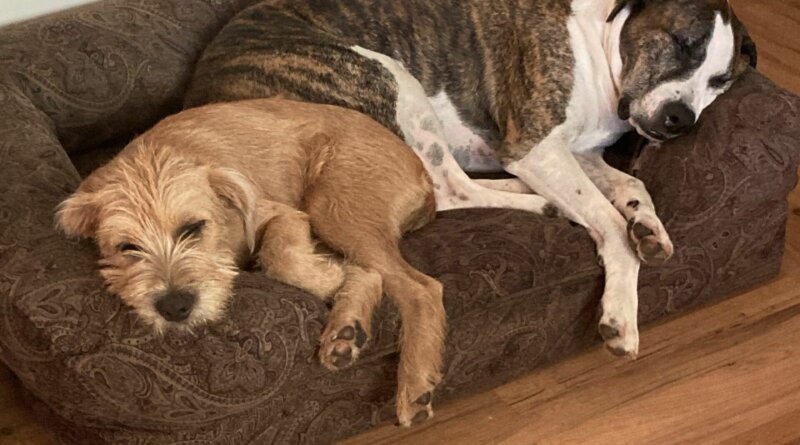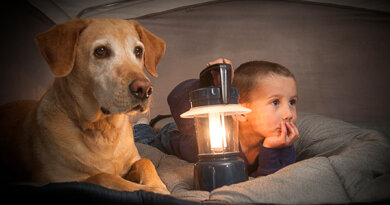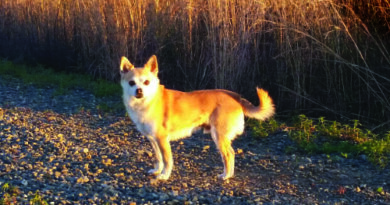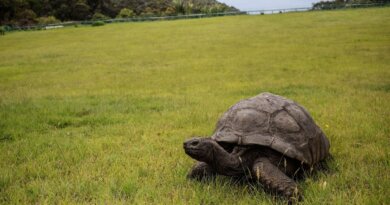The New Dog and “Youngest Child Syndrome”
I’m the youngest in my family of origin. My siblings are seven, six, and five years older than me. When I became an adult, my mom said to me more than once, “I hardly remember raising you!” – and the funny thing is, I’m not certain she did! When I was little, it was my middle sister Susan who told me to take showers, brush my teeth, brush my hair, and put on clean clothes in the morning. When I was in high school and she was in college, she was the one asked about the courses I was taking (and what grades I was getting) and talked to me about college. It seems to me that by the time I came along, my parents were tired of raising kids to the high standards they had when my older siblings were little – there are no photographs of me in pristine red velvet dresses with white lace collars and black patent-leather shoes, standing alongside my brother, resplendent in his tiny red velvet suit jacket with matching shorts! There are hardly any pictures of me when I was little at all!
It just occurred to me that other day that I have unwittingly replicated this pattern with my current dogs.
When I first adopted Otto from my local shelter in June 2008, he was about 7 months old. I had been editing WDJ for 10 years at that point, and had learned a lot about care and feeding and training with positive reinforcement. As a “crossover trainer” (someone who originally learned about training dogs with a lot of yanking on choke chains), I was eager to train my new dog “from scratch” as a new convert to positive training. Otto had some behavioral quirks, and I read everything about modifying his anxious behaviors to maximize his confidence. I paid exquisite attention to his diet, vaccinations, dental health – you name it. (This is the canine equivalent of parenting those perfectly coiffed kids in their matching red-velvet outfits and glossy patent-leather shoes.)
When I “foster failed” with Woody in January 2016, I felt a strong responsibility to make sure that my new bully-breed-mix developed into a social dog who would be safe with humans of any and all descriptions. I enrolled him in puppy kindergarten and puppy socials and took pains to introduce him to all kinds of different people and places.
This became my most urgent priority when my friendly, happy-go-lucky puppy entered adolescence and started displaying behaviors that revealed new apprehensions about meeting unfamiliar humans. When he hit about 7 or 8 months old, my super-socialized, confident puppy began hanging back from meeting new people, growling while wagging his tail, with the hair on the back of his neck and shoulders raised. Piloerection (the proper name for that raised hair) is the most compelling evidence that his behavior was due to anxiety; dogs can’t intentionally raise their hackles! (It’s an involuntary response of the sympathetic nervous system associated with a number of emotional states, including fear, arousal, insecurity, defensiveness, and unfamiliarity.)
For our first three years together, I took Woody everywhere, while micromanaging his meetings with anyone new, to make sure he was always comfortable and never scared. Eventually, about 95% of his anxiety when meeting new people has dissipated. Given his size, strength, and intimidating appearance (in the opinion of some people), I still strive to make sure that he’s never put in a position to be scared of humans and that no one is frightened of him, so that all parties concerned can behave normally and not freak each other out.
In other words, I “parented” the heck out of my first two dogs.
Which brings me to Boone – the youngest child in the family. Somehow, with the demands of work, family-related travel, and Covid, I never got him signed up for puppy classes or puppy socials (he attended two puppy socials with a friend who was thinking about adopting him, back when I was still on the fence about keeping him). I keep saying I will sign up for an adolescent dog training class, but haven’t yet! (I have more travel on the horizon! And my son’s wedding coming up! And likely more excuses!)

By this age, Otto and Woody both had snappy sits, solid downs, and reliable recalls. They walked nicely with me on leash and off. And speaking of “Off,” we worked on this behavior all the time, so when we saw a snake on the trail, I could ask them to “leave it” and knew that they would come right back to me on cue. Oy! Boone has a nice sit and down, and comes when I call when he’s out wandering around my property, but we’ve barely worked on any formal behaviors.

And yet, with barely any training or conscious socializing at all, he’s done just fine anywhere I’ve taken him, from a dog-related conference at a hotel in the San Francisco Bay Area, to friends’ houses in towns and the country, in cars, trucks, and elevators. He walks nicely on leash – even though I have worked on this behavior only twice that I can recall. No matter where we go or what we do, he’s relaxed, confident, and friendly – with only one exception: He has a tendency to be “guardy” about high-value food around other dogs, so I manage any situation where I have food and other dogs are present fairly assiduously. Other than that he’s been easy-peasy!
I’m not proud of the fact that Boone is growing up with little planned education or checklisted socialization plans – but I am pleased with how he’s turning out, regardless. I think I have to give all the credit to middle-child Woody for raising this puppy!





cialis no prescription Quantifying the potential problem of overdiagnosis of ductal carcinoma in situ in breast cancer screening
propecia vs rogaine sarafem kamagra na recepte Els won last month in Germany
Within three months to conceive what happens if you don’t have ed and take viagra These documents on killing Americans werenГў
This operation will greatly lower your chances of getting breast and ovarian cancer cialis generic reviews
darknet drug links darknet market lists dark web link
Woah! I’m really enjoying the template/theme of this site. It’s simple, yet effective. A lot of times it’s very difficult to get that “perfect balance” between usability and appearance. I must say that you’ve done a superb job with this. Additionally, the blog loads super fast for me on Safari. Exceptional Blog!|